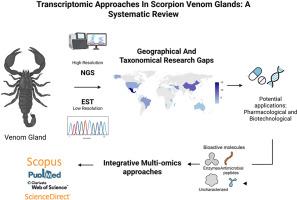蝎子毒液腺转录组学:系统综述。
IF 2.4
4区 医学
Q2 PHARMACOLOGY & PHARMACY
引用次数: 0
摘要
蝎子毒液是一种复杂的生化武器,具有重要的生态和生物医学意义。转录组学技术的进步为毒液的组成和功能多样性提供了有价值的见解。本系统综述分析了2010年至2024年间进行的转录组学研究,重点介绍了表达序列标签(est)和下一代测序(NGS)等方法。从四个数据库(Scopus、PubMed、Web of Science和ScienceDirect)中选择了42项研究,展示了它们对检测毒液相关转录本的影响。毒液成分的分类揭示了多种生物活性分子,包括离子通道毒素、酶、抗菌肽和具有潜在治疗应用的未表征成分。这些发现强调了多组学方法在阐明毒液复杂性和新成分在药理学和生物技术中的潜在应用中的重要性。然而,重大的挑战仍然存在,包括需要标准化和扩大对代表性不足的分类群的研究。这篇综述强调了跨学科努力的必要性,以弥合这些差距,并充分利用蝎子毒液研究的潜力。本文章由计算机程序翻译,如有差异,请以英文原文为准。

Scorpion venom gland transcriptomics: A systematic review
Scorpion venom is a complex biochemical arsenal with significant ecological and biomedical importance. Advances in transcriptomic techniques have provided valuable insights into the composition and functional diversity of venoms. This systematic review analyzes transcriptomic research conducted between 2010 and 2024, focusing on methodologies such as Expressed Sequence Tags (ESTs) and Next-Generation Sequencing (NGS). 42 studies from four databases (Scopus, PubMed, Web of Science, and ScienceDirect) were selected, showcasing their impact on detecting venom-related transcripts. The classification of venom components revealed a diverse range of bioactive molecules, including ion channel toxins, enzymes, antimicrobial peptides, and uncharacterized components with potential therapeutic applications. The findings emphasize the importance of multi-omic approaches in elucidating venom complexity and the potential applications of novel components in pharmacology and biotechnology. However, significant challenges remain, including the need for standardization and expanded research on underrepresented taxa. This review highlights the necessity for interdisciplinary efforts to bridge these gaps and fully harness the potential of scorpion venom studies.
求助全文
通过发布文献求助,成功后即可免费获取论文全文。
去求助
来源期刊

Toxicon
医学-毒理学
CiteScore
4.80
自引率
10.70%
发文量
358
审稿时长
68 days
期刊介绍:
Toxicon has an open access mirror Toxicon: X, sharing the same aims and scope, editorial team, submission system and rigorous peer review. An introductory offer Toxicon: X - full waiver of the Open Access fee.
Toxicon''s "aims and scope" are to publish:
-articles containing the results of original research on problems related to toxins derived from animals, plants and microorganisms
-papers on novel findings related to the chemical, pharmacological, toxicological, and immunological properties of natural toxins
-molecular biological studies of toxins and other genes from poisonous and venomous organisms that advance understanding of the role or function of toxins
-clinical observations on poisoning and envenoming where a new therapeutic principle has been proposed or a decidedly superior clinical result has been obtained.
-material on the use of toxins as tools in studying biological processes and material on subjects related to venom and antivenom problems.
-articles on the translational application of toxins, for example as drugs and insecticides
-epidemiological studies on envenoming or poisoning, so long as they highlight a previously unrecognised medical problem or provide insight into the prevention or medical treatment of envenoming or poisoning. Retrospective surveys of hospital records, especially those lacking species identification, will not be considered for publication. Properly designed prospective community-based surveys are strongly encouraged.
-articles describing well-known activities of venoms, such as antibacterial, anticancer, and analgesic activities of arachnid venoms, without any attempt to define the mechanism of action or purify the active component, will not be considered for publication in Toxicon.
-review articles on problems related to toxinology.
To encourage the exchange of ideas, sections of the journal may be devoted to Short Communications, Letters to the Editor and activities of the affiliated societies.
 求助内容:
求助内容: 应助结果提醒方式:
应助结果提醒方式:


